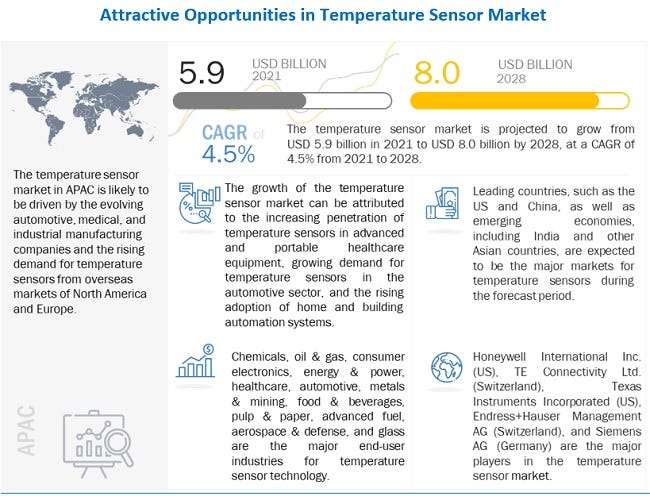The report “Temperature Sensor Market With COVID-19 Impact by Product Type (Thermocouples, RTDS, Thermistors, Temperature Sensor ICS, Infrared, and Fiber Optic Temperature Sensors), Output, Connectivity, End-User Industry, & Region — Global Forecast to 2028”, is estimated to be valued at USD 5.9 billion in 2021 and reach USD 8.0 billion by 2028; it is anticipated to grow at a CAGR of 4.5% during the forecast period (2021–2028).
Browse 248 market data Tables and 71 Figures spread through 277 Pages and in-depth TOC on “Temperature Sensor Market With COVID-19 Impact by Product Type (Thermocouples, RTDS, Thermistors, Temperature Sensor ICS, Infrared, and Fiber Optic Temperature Sensors), Output, Connectivity, End-User Industry, & Region — Global Forecast to 2028”
View detailed Table of Content here — https://www.marketsandmarkets.com/Market-Reports/temperature-sensor-market-522.html

The continuous demand for temperature sensors, which are integrated into devices like wearable bands, smartphones, and patient monitoring devices, from industries such as consumer electronics and healthcare is driving the temperature sensor market growth. For the past few years, the demand for reliable, high-performance, and low-cost sensors has been increasing, leading to the development of new technologies like micro and nanotechnology, which provides benefits such as miniaturization, low power consumption, and mass production. However, high initial cost involved in advanced sensors is expected to restraint market growth.
To know about the assumptions considered for the study, Request for Free Sample Report
The temperature sensor market is projected to grow from USD 5.9 billion in 2021 to USD 8.0 billion by 2028, at a CAGR of 4.5% from 2021 to 2028. The continuous demand for temperature sensors, which are integrated into devices like wearable bands, smartphones, and patient monitoring devices, from industries such as consumer electronics and healthcare is driving the temperature sensor market growth. For the past few years, the demand for reliable, high-performance, and low-cost sensors has been increasing, leading to the development of new technologies like micro and nanotechnology, which provides benefits such as miniaturization, low power consumption, and mass production. However, high initial cost involved in advanced sensors is expected to restraint market growth.
Impact of Covid-19 on Temperature Sensor Market:
The COVID-19 pandemic has had a low impact on the growth of the temperature sensor market. From a regional point of view, the outbreak of COVID-19 has caused a major setback to the export-oriented economies owing to the temporary shutting down of manufacturing plants. For instance, the automotive industry of Germany has been severely affected as most of the automobile trade takes place with China and Italy. Besides the issues related to exports and imports, the growth of the manufacturing industry in Germany has been hampered due to the closure of manufacturing plants and slowdown in operations to contain the spread of COVID-19.
The consumer electronics industry, which comprises wearables, laptops, desktops, and other appliances, has also been impacted, with production declining due to disruptions in the global supply chain, including China, which is the major hub of OEMs in this segment. However, from the consumers’ perspective, there is a growth in the adoption of smartphones and other gadgets, which is supporting the growth of the temperature sensor market. The healthcare industry also witnessed significant demand for thermometers, MRI machines, and imaging diagnostics equipment, which have temperature sensors installed in them. Therefore, the healthcare industry is likely to account for a significant share of the temperature sensor market during the pandemic as well as after its impact subsides.
About MarketsandMarkets™
MarketsandMarkets™ provides quantified B2B research on 30,000 high growth niche opportunities/threats which will impact 70% to 80% of worldwide companies’ revenues. Currently servicing 7500 customers worldwide including 80% of global Fortune 1000 companies as clients. Almost 75,000 top officers across eight industries worldwide approach MarketsandMarkets™ for their painpoints around revenues decisions.
Our 850 fulltime analyst and SMEs at MarketsandMarkets™ are tracking global high growth markets following the “Growth Engagement Model — GEM”. The GEM aims at proactive collaboration with the clients to identify new opportunities, identify most important customers, write “Attack, avoid and defend” strategies, identify sources of incremental revenues for both the company and its competitors. MarketsandMarkets™ now coming up with 1,500 MicroQuadrants (Positioning top players across leaders, emerging companies, innovators, strategic players) annually in high growth emerging segments. MarketsandMarkets™ is determined to benefit more than 10,000 companies this year for their revenue planning and help them take their innovations/disruptions early to the market by providing them research ahead of the curve.
Comments
Post a Comment